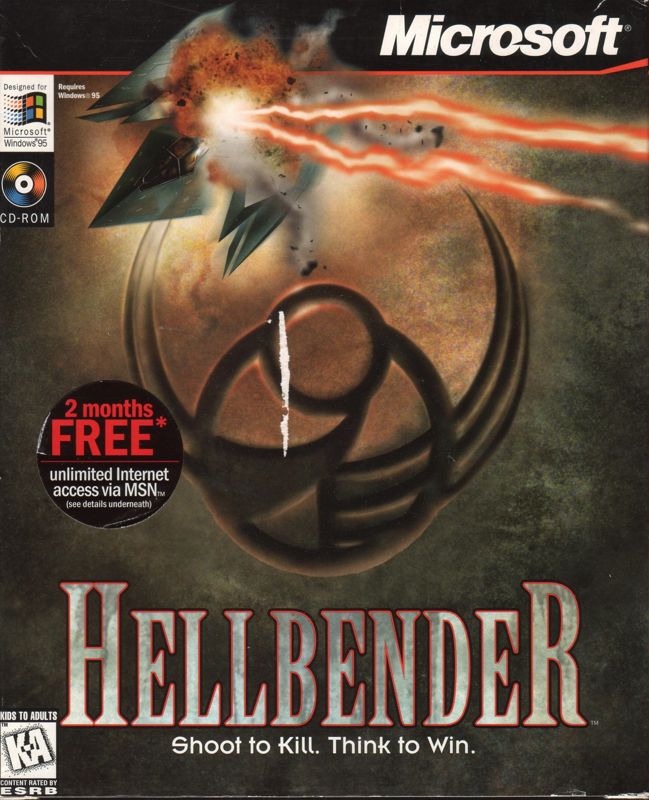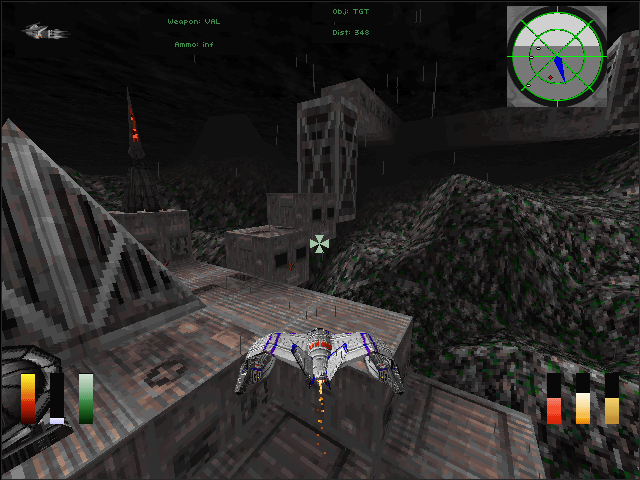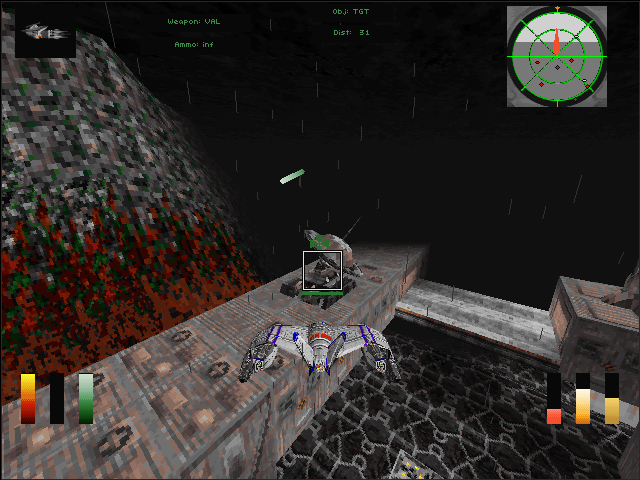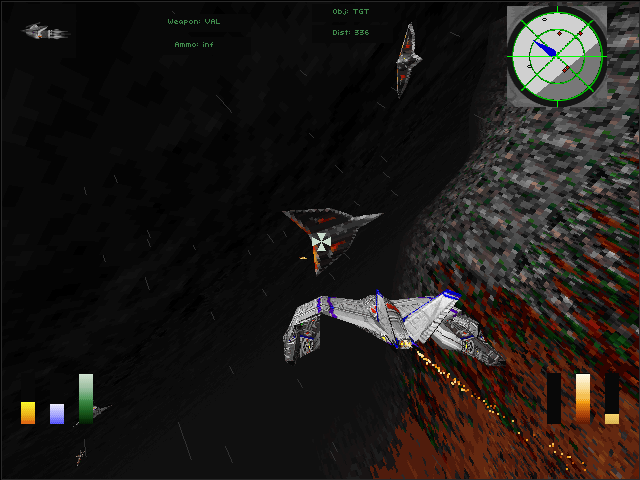Retro Replay Review
Gameplay
The core gameplay of Hellbender centers on piloting the titular assault craft through a variety of mission types, from high-altitude dogfights to underground tunnel runs. The controls are responsive and intuitive, allowing you to switch seamlessly between first-person and third-person perspectives. You’ll navigate vast open skies, swoop close to the ground to take out fortified installations, and even dive into subterranean caverns to hit critical switches. Each mission challenges you to balance aggression with strategy, since power-ups and weapon caches are hidden in hard-to-reach areas.
(HEY YOU!! We hope you enjoy! We try not to run ads. So basically, this is a very expensive hobby running this site. Please consider joining us for updates, forums, and more. Network w/ us to make some cash or friends while retro gaming, and you can win some free retro games for posting. Okay, carry on 👍)
One of Hellbender’s standout features is its diverse arsenal: with ten unique weapons at your disposal, you can tailor your loadout to suit different combat scenarios. Railguns and plasma bolts excel at long-range engagements, while proximity mines and flak cannons are devastating in close-quarters bursts. Experimenting with weapon combos becomes a mini-game of its own, particularly when facing waves of Bion fighters or heavily shielded ground turrets. The thrill of locking onto multiple targets and unleashing a volley of missiles never grows old.
Beyond straightforward shootouts, Hellbender sprinkles in light puzzle elements that break up the action. Some objectives require activating specific switches in a precise order, forcing you to map out tunnel systems and manage your craft’s energy reserves. These moments of pause add a welcome layer of depth, ensuring the game isn’t just a nonstop bulletfest. They also reward careful exploration, since you must scour levels for hidden power-ups that bolster your shields or upgrade your weapons.
Multiplayer support further extends the replay value, allowing you to dogfight friends in local or online matches. Customizable arenas let you toggle hazards and pick weapon sets, turning a quick skirmish into a frantic fight for air superiority. While the single-player campaign is the main draw, the competitive modes offer hours of additional fun if you crave PvP mayhem.
Graphics
Hellbender’s graphics engine marks a significant leap from its predecessor, Fury³, delivering richly detailed environments that range from sunlit cloudscapes to shadowy underground complexes. The draw distance is impressive for its era, letting you spot distant enemy formations or looming structures well before you engage. Terrain textures are crisp, and environmental details—such as billowing smoke plumes and dynamic lighting—help ground the sci-fi setting in a tangible reality.
Enemy models and vehicle designs are equally well-crafted, with the alien Bion craft featuring menacing organic curves contrasted against the angular, industrial design of human fortresses. Explosions light up the sky with brilliant particle effects, and shockwaves ripple across the screen when a missile impacts a nearby surface. Even the cockpit HUD is polished, displaying vital information like ammo counts and radar blips without cluttering your view.
Performance remains steady across most hardware configurations of its time, though extremely dense particle effects can cause occasional frame dips in large-scale battles. However, configurable graphics settings let you dial down effects in exchange for a smoother framerate. This balance ensures that both enthusiasts with high-end rigs and players on modest systems can enjoy the visual spectacle.
Cutscenes blend in-engine footage with pre-rendered sequences, providing narrative context without jarring visual discontinuities. Voice acting during mission briefings is clear and emotive, lending weight to the council’s dire warnings and your character’s lone-hero status. Overall, Hellbender’s graphical presentation stands as one of the game’s most enduring strengths.
Story
Hellbender opens with a dire communiqué: the Bion commandos have annihilated your training school, leaving the world defenseless. As the lone surviving pilot, you’re thrust back into service to fly the experimental Hellbender assault craft. This premise sets an urgent tone from the outset, giving your missions immediate stakes. The narrative doesn’t overstay its welcome; instead, it delivers concise briefings that keep you focused on the next objective.
Throughout the campaign, you uncover hints of a larger Bion conspiracy—shields that self-repair, clandestine research outposts, and the mysterious origins of your own craft. These story beats are woven into mission design, as you intercept transmissions or recover enemy data logs in hidden bunkers. While not deeply philosophical, the plot hits every expected sci-fi beat with enough flair to steer clear of cliché.
Characterization is sparing but effective: your interactions with the council and ground commanders underscore the desperation of humanity’s last stand. The voice cast delivers solid performances, capturing both the weariness of a returning war hero and the steely resolve of military brass. Though you never leave the cockpit, these audio snippets build a connection that motivates you to push forward against overwhelming odds.
In the end, Hellbender’s story serves as a functional backbone, providing context and urgency without overshadowing the frenetic action. It’s a lean narrative that plays to the game’s strengths, offering just enough intrigue to keep you invested across its dozen-plus missions.
Overall Experience
Hellbender delivers a gratifying cocktail of high-speed aerial combat, clever level design, and narrative urgency. The seamless transition between open-air dogfights, ground assault, and claustrophobic tunnel runs ensures that no two missions feel identical. Add to that the wealth of weaponry, hidden power-ups, and multiplayer skirmishes, and you have a package that caters to both single-player adrenaline junkies and competitive flyers alike.
While the graphics engine may show its age to modern eyes, the game’s aesthetic choices and smooth performance still impress. The responsive controls and varied mission objectives stand the test of time, making Hellbender feel as fresh today as it did at release. Occasional difficulty spikes and the requisite backtracking for puzzle switches can frustrate, but these moments are balanced by the sheer spectacle of blowing apart Bion dreadnoughts from seventy thousand feet in the air.
For fans of classic 3D shooters, Hellbender is a must-play—especially if you enjoyed Fury³ or Terminal Velocity. Its blend of arcade-style mayhem and light simulation elements offers a unique flight experience that few titles have replicated since. Multiplayer adds further hours of replay, while the single-player campaign packs a satisfying run that you’ll want to revisit with different weapon loadouts.
In summary, Hellbender stands as a high watermark in the vehicle shooter genre. It rewards exploration, skillful piloting, and strategic use of its diverse armory. Whether you’re tackling the story missions or duking it out with friends, Hellbender promises an engaging, explosive ride that lives up to its name.
 Retro Replay Retro Replay gaming reviews, news, emulation, geek stuff and more!
Retro Replay Retro Replay gaming reviews, news, emulation, geek stuff and more!









Reviews
There are no reviews yet.